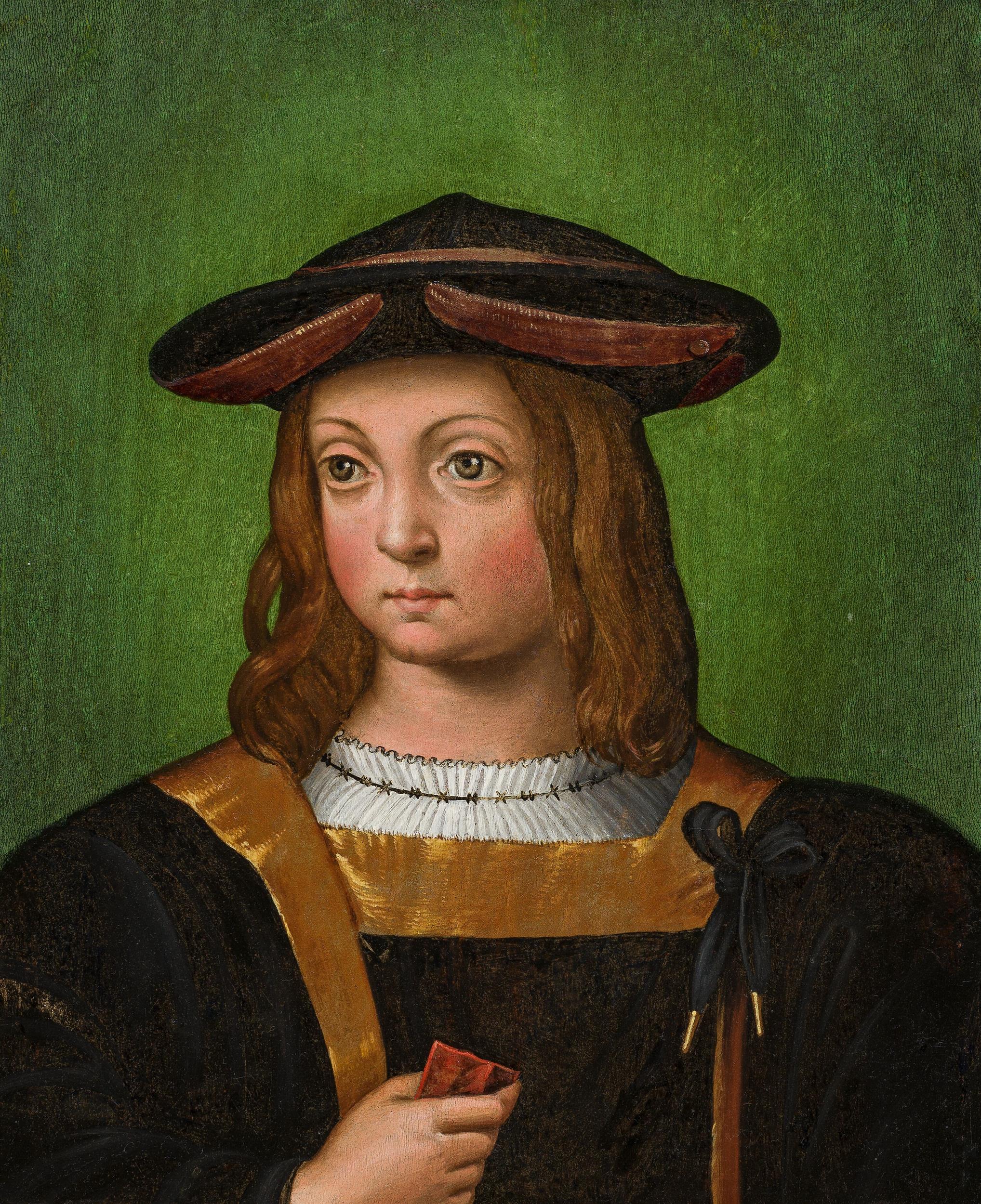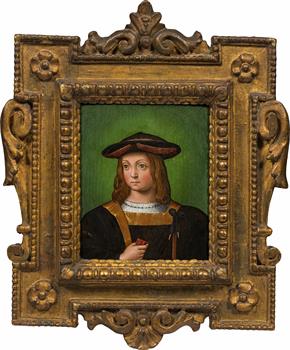2036
Francesco Bonsignori
(Verona um 1455 - 1519 Caldiero)
„Child Portrait of Federico II Gonzaga (1500-1540)“
1503
oil on panel; framed
24.8 x 20 cm
customs seal of the territory of the Granduca della Toscana on the reverse
collection inventory number with crown: no 14 (possibly of the ducal collection of Gonzaga)
Provenance
Mantova, Isabella d'Este (1474-1539), until 5 November 1503;
documented in Rome from 25 November 1503: Gian Francesco II Gonzaga (1466-1519) or Pope Julius II. (1453-1513);
private property, Germany
Prof. Dr. Gaudenz Freuler has identified the painting and analysed it in detail from an art historical aspect (report, Zurich, 2022, enclosed).
Estimate: € 150.000 - 300.000
Hammer price: € 140.000*
under reserve, Reserve Price: € 150.000
Auction is closed.
The painting with the bust of a boy dressed in a noble uniform and beret is one of the earliest testimonies of the then still rather rare child portraits in Italian Renaissance painting. Prof. Gaudenz Freuler, Zurich, was able to identify the sitter on the basis of a preparatory drawing and historical documents as the three-year-old Federico II Gonzaga, son of Isabella d'Este and hereditary prince of the Marquis of Mantua, Gian Francesco II Gonzaga (1466-1519).
The hitherto unpublished and only recently rediscovered portrait of the child is the oil rendering of a drawing by Francesco Bonsignori formerly in Swiss private property (cf. Gaudenz Freuler "El pù bel ritracto facesse mai Magistro Francesco", in: Pantheon, LIV, 1996, pp. 50-58). The artist, who came from Verona, was a court painter in the service of the Gonzaga family in Mantua and was directly inspired there by the work of Andrea Mantegna (1431-1506) - some drawings executed by Bonsignori have even been attributed to him in the past.
In the meantime, it has not only been possible to identify this painting from an artistic and stylistic point of view, but its genesis is also documented in an exchange of letters between Isabella d'Este and her husband, who was in Rome at the court of Julius II, newly elected Pope, at the time in question (edited in: Clifford M. Brown, "Francesco Bonsignori: Painter to the Gonzaga court - New documents", in: Accademia Virgiliana Mantova, Atti e e Mermorie, n.s., XLVII, 1979, pp. 81-96).
In one of these letters, Isabelle d'Este describes Bonsignori's portrait drawing of her son as the most beautiful drawing she has ever seen by the artist: "...el più bel ritractro facesse mai Magistro Francesco (sc. Bonsignori)....". This is a judgement that, from Isabelle d'Estes' mouth, is significant beyond her motherly pride, for she was regarded as an extremely critical and demanding patron of the arts in the circle of the artistic elite working for her.
The same correspondence in autumn of 1503 also reveals that Bonsignori had to translate his charcoal drawing into a painting in a very short time - and in fact in two versions. One of the two small portraits of Federico II went to his father, who was in Rome, while the other was intended as a gift for Julius II, elected as Pope just a few days before. With this portrait, Gian Francesco Gonzaga probably intended to present his heir and thus also the continuity of the Gonzaga family to the new powerful dignitary. This also explains the "official" costume of a child's uniform with beret, which is rather strange for a small child. After all, in the correspondence of the parents, explicit reference is made to the papal "Swiss Guard" when speaking of "our little Swiss (il svizaretto nostro)" (cf. Freuler 1996, opt. cit. pp. 53-54). A similar depiction can be found on a coin, probably also showing Federico II, in the Musées royaux des Beaux Arts, Brussels (inv. no. 264).
When compared directly with the drawing (38.5 x 28.5 cm), the childlike nature of the sitter in the smaller, and thus more portable panel painting seems to have been somewhat reduced in favour of a slightly superimposed display of prestigious self-confidence. The status of the future hereditary prince and marchese was to be underlined. As the historical source of the correspondence proves, the execution of both oil paintings had to take place shortly after the drawing: probably begun on 16 October 1503, the panel paintings left the city of Mantua for Rome as early as 5 November 1503, where they also arrived no later than 25 November 1503 at the recipient's home.
„Die hohe Bedeutung des hier in Frage stehenden Kinderporträts des dreijährigen Federico II. Gonzaga liegt nicht allein im Kunsthistorischen, nämlich als eines der frühesten Kinderporträts überhaupt und als eines der besten Porträts der eben gerade auf diese Sparte spezialisierten Hofmalers der Gonzaga, Francesco Bonsignori, sondern ganz speziell auch in seiner historischen und kulturgeschichtlichen Bedeutung, als das früheste auf uns gekommene Porträt des späteren Erbauers des Palazzo del Te, der später als Erwachsener selbst von Tizian (Madrid, Prado) porträtiert wurde.
Durch seine reichhaltige Dokumentierung über den Briefwechsel zwischen Isabella d’Este, einer der berühmtesten und schillerndsten Renaissance Mäzenen, und ihrem Gatten Gian Francesco Gonzaga, gilt dieses Porträt als eines der am besten dokumentierten Porträts der Renaissance, dessen künstlerische Genesis über Archivalien und die vorbereitende Zeichnung in all ihren Facetten und lückenlos erschlossen ist.
Offen bleibt bloss die Frage, ob vorliegendes Bild jene Variante ist, die an den Vater des Porträtierten, Gian Francesco Gonzaga, ging, oder ob es mit jenem Porträt identisch ist, das Papst Julius II. geschenkt wurde. ...“ ("The great importance attached to the child portrait of the three-year-old Federico II. Gonzaga lies not only in art history, namely as one of the earliest child portraits ever painted and as one of the best portraits by Francesco Bonsignori, the Gonzaga court painter who specialised in this field, but also in its historical and cultural-historical significance as the earliest portrait of the future builder of the Palazzo del Te, who was later portrayed as an adult by Titian (Madrid, Prado).
Due to the rich documentation of the correspondence between Isabella d'Este, one of the most famous and dazzling Renaissance patrons, and her husband Gian Francesco Gonzaga, this portrait is considered to be one of the best-documented portraits of the Renaissance, whose artistic genesis has been fully explored in all its facets via archival documents and the preparatory drawing.
The only question that remains open is whether this painting is the variant that went to the sitter's father, Gian Francesco Gonzaga, or whether it is identical with the portrait that was given to Pope Julius II. ...") (cf. report by Prof. Dr. Gaudenz Freuler)


